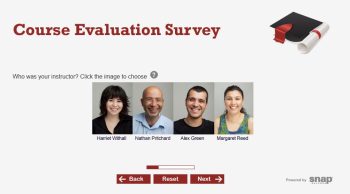What are the advantages and disadvantages of Open questions in Course Evaluations?
This content was updated on November 16, 2018.
Course Evaluations often times use Open questions (questions that prompt a unique response) for many reasons. Typically, Open questions are used to get qualitative information about the course, program, or instructor.
The answer box of an Open question is undefined and can accept different types of responses:
| Numeric Response | Of the 18 total classes in this course, how many did you attend? |
| Date Response | What were the dates of the classes not attended? |
| Time of Day Response | What time of day did this course meet? |
| Free Text or Literal Response | Would you like to comment further on this course? |
Note: Although you can ask for numeric, date, and time responses with an Open question, these types of responses are better suited in the format of a Closed question. Comments and opinions are the best answered in the format of an Open question.
Advantages of Open Questions in Course Evaluations:
- Permits an unlimited range of answers
- Reveals how the respondents think about the question
- Responses can be used to expand on and clarify closed responses
Disadvantages of Open Questions in Course Evaluations:
- Takes more time and effort to respond to the questions
- Literal responses can be difficult for respondents not familiar with expressing own views and opinions
- Answers may differ in level of details or scope
- Limited control over length of response
- Analysis relies on coding and that may be difficult, costly, and time consuming
Understanding the pros and cons to Open questions in your course evaluations will help you to develop the right questionnaire to extract the information you need for course analysis and reporting.



